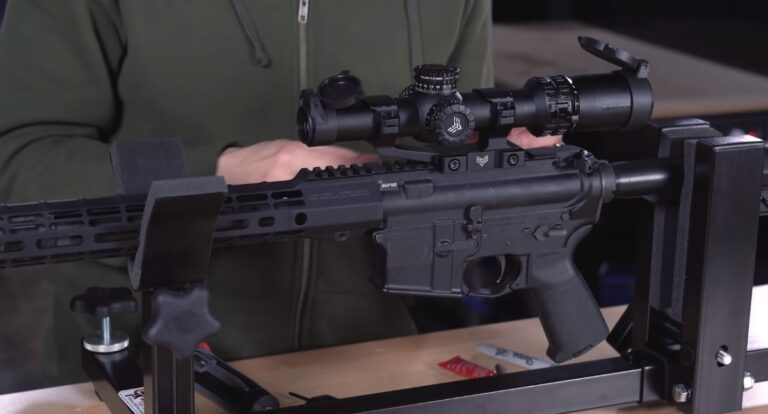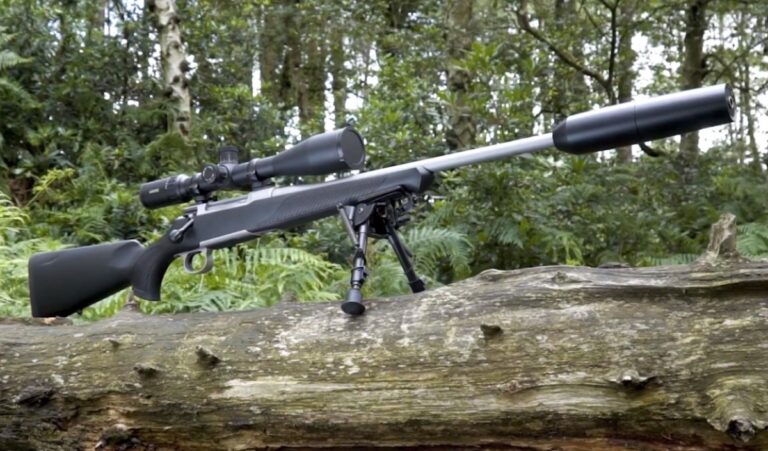Best 300 Blackout Scopes and Optics in 2023

When it comes to enhancing accuracy and performance in shooting, a quality scope can make a world of difference. Among the myriad choices available, .300 Blackout scopes stand out for their precision and adaptability. These scopes cater specifically to the needs of .300 Blackout rifles, amplifying their capabilities and ensuring an optimal shooting experience.
Scope isn’t just an accessory; it’s an integral part of a shooter’s gear. It defines accuracy, extends effective range, and allows for better target acquisition. For .300 Blackout rifles, the proper scope can maximize the potential of this caliber, transforming shooting sessions into precise, satisfying endeavours.
1. Trijicon VCOG 1-6×24
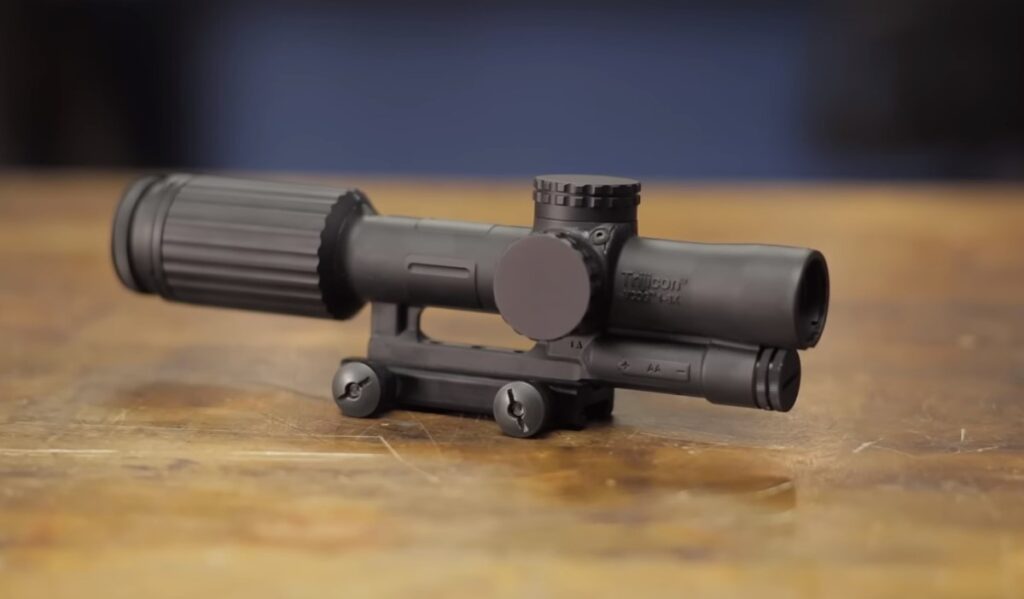
The Trijicon VCOG 1-6×24 is like having the Rolls Royce of scopes in your hands. I’ve used this beauty extensively, and let me tell you, it’s a work of art that genuinely delivers. However, like anything else, a couple of things popped up during my time with it.
Let’s dive into the brilliance first. This scope? It’s a marvel. Crystal-clear lenses make every view a spectacle, whether at 1X or zoomed in at 6X. Are both eyes open at 1X? It’s a game-changer for close-range action, like having superpowers in a shootout.
But, hold on, there were a few bumps. Price? It’s not for the faint-hearted, but trust me, you get what you pay for. It’s like investing in a high-end sports car—expensive, but the performance matches the cost.
Weight? It’s a hefty one. Carrying it around all day might tire your arms, but when you see the precision it offers, you’ll forgive the weight.
Oh, and did I mention the durability? It’s like it’s made from the armour of the gods—weatherproof, shockproof, basically indestructible.
Trijicon VCOG 1-6×24 if you’re after unparalleled quality and performance. It’s like owning a masterpiece—it might come at a price, but the experience it offers is priceless.
Pros:
- Crystal-clear optics
- Rugged, durable construction
- Versatile reticle for close-quarter and long-range
- Both eyes open at 1X
- Reliable performance in various conditions
Cons:
- Higher price point
- Slightly heavier
- Minor brightness issues at high settings
- Limited eye relief

Trijicon VCOG 1-6×24 Rifle Scope
2. Vortex Crossfire II 4-16×50
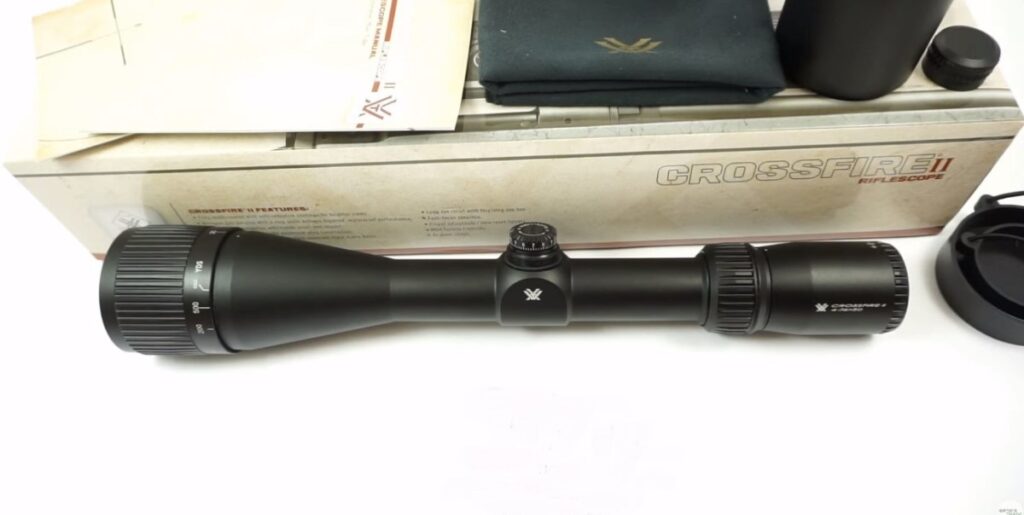
The Vortex Crossfire II 4-16×50 is like the dependable Swiss Army knife of scopes. I’ve taken this optic out for quite a spin, and overall, it does the job pretty darn well. However, a few hiccups did pop up along the way.
First off, the good stuff. This scope? It works. The image clarity at lower magnifications is impressive, making those mid-range shots a walk in the park. Plus, the magnification range from 4X to 16X. It’s like having multiple scopes in one, catering to different shooting needs.
But here’s the catch. The eye relief can be finicky, especially at higher magnifications. It’s like trying to find the perfect spot in a crowded room—it takes a bit of effort, but once you’re there, it’s comfy.
Mounting? It’s usually straightforward, but occasionally, the rings or mounts might need a little tweaking to get that perfect alignment. Think of it like putting together furniture from a famous store—it’s easy but sometimes needs a bit of adjustment.
One more thing: the turret clicks. They’re not as crisp as some higher-end scopes. Adjusting might feel a bit vague, but with a bit of patience, you’ll get it right.
The Vortex Crossfire II 4-16×50 if you want versatility without breaking the bank. It’s like that trusty old tool in your shed—it might have a few quirks, but it gets the job done reliably.
Pros:
- Impressive magnification range
- Good image clarity at mid-range
- Versatile for various shooting needs
- Affordable for its features
- Solid performance for the price
Cons:
- Eye relief can be finicky
- Turret adjustments might feel vague
- Mounting may require tweaking
- Battery life could be better for illumination

Vortex Crossfire II 4-16×50 Rifle Scope
3. Primary Arms SLX 1-6×24

The Primary Arms SLX 1-6×24 is like a hidden gem among scopes. I’ve had the pleasure of using this optic extensively, and let me tell you, it’s a reliable companion, but not without a few things to note.
First off, the good stuff. This scope? It works, and it works well. The clarity at 1X is fantastic—like looking through a crystal-clear window. And when you crank it up to 6X, the image remains sharp, making those mid-range shots a breeze.
But here’s the catch. The illumination might not be the brightest in broad daylight. It’s like trying to read your phone screen in direct sunlight—manageable but not the best. However, in low-light conditions, it’s a different story—the illumination truly shines.
Eye relief? It’s decent but not overly forgiving. Finding the sweet spot takes a bit of trial and error, but once you get it, shooting becomes comfortable.
Now, mounting—is usually straightforward, but sometimes, achieving perfect alignment might need a bit of patience. It’s like hanging a picture frame straight—it might take a couple of tries, but it’s worth it in the end.
The Primary Arms SLX 1-6×24 for its versatility and reliability. It’s like that reliable buddy who may not be perfect, but when it counts, it’s got your back.
Pros:
- Excellent clarity at both low and high magnifications
- Versatile illumination for low-light conditions
- Good balance of features and affordability
- Decent eye relief
- Reliable performance overall
Cons:
- Illumination could be brighter in daylight
- Eye relief is not overly forgiving
- Mounting might need adjustment for perfect alignment
- Limited in terms of brightness in certain conditions

Primary Arms SLx Series 1-6 x 24 Rifle Scope
4. Steiner P4Xi Rifle Scope
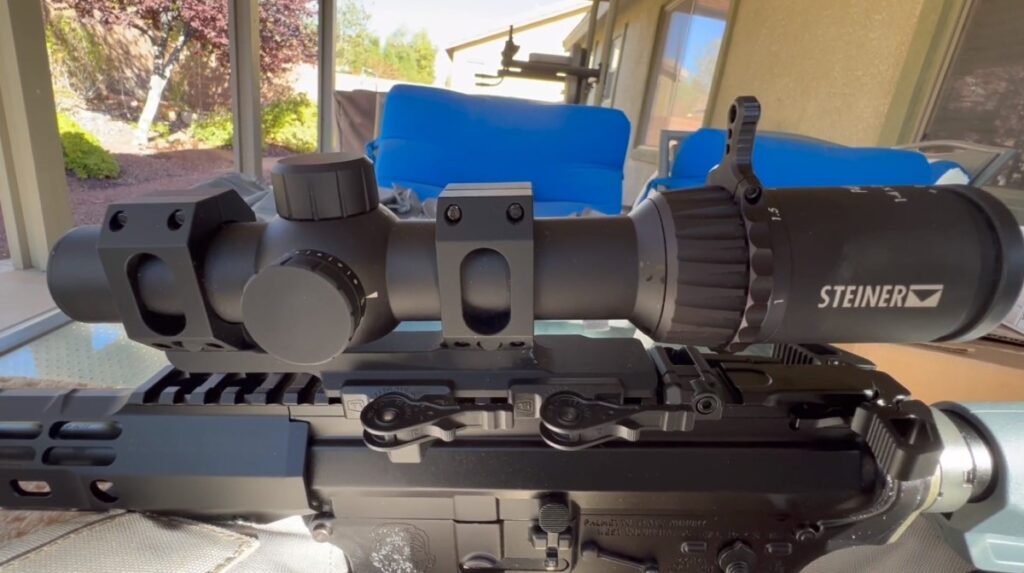
The Steiner P4Xi is like the reliable partner you want by your side on the shooting range. When I used this scope, I faced very few problems, but they were more about fine-tuning than deal-breakers.
Let’s talk about the good stuff first. This scope? It works. It’s like having a reliable friend who never lets you down. The clarity of the glass is fantastic, making those long-range shots feel like a walk in the park. The P4Xi handled various lighting conditions impressively well. From bright daylight to those dusky evenings, it maintained its clarity.
Now, about the hiccups. Occasionally, I found the adjustment dials a tad stiff at first, but once you break them in, it’s smooth sailing. It’s like that brand-new pair of shoes you need to wear a few times before they fit perfectly. Once you’re in tune, the adjustments are precise and stay put.
What truly impressed me was the simplicity. The reticle is clean and straightforward, making target acquisition a breeze. No clutter, no confusion. It’s like having a conversation with an old friend—clear, direct, and to the point.
One thing worth noting: eye relief. It could be more forgiving. You need to get your eye placement just right, but once you do, it’s golden.
This scope is a gem. Sure, it might have a couple of quirks, but show me something perfect—I’ll wait. For the price and the performance it delivers, the Steiner P4Xi is a solid choice. It’s like finding that favourite spot in the woods; you know you can rely on it.
Pros:
- Excellent optical clarity
- Compact and durable design
- Simple and functional reticle
- Precise adjustments once set
- Good performance in various lighting conditions
Cons:
- Adjustment dials might be stiff initially
- Battery life might drain faster than expected
- Mounting might require additional accessories
- Limited eye relief

Steiner P4Xi 1-4x24mm Rifle Scope
5. ATN ThOR 4 640
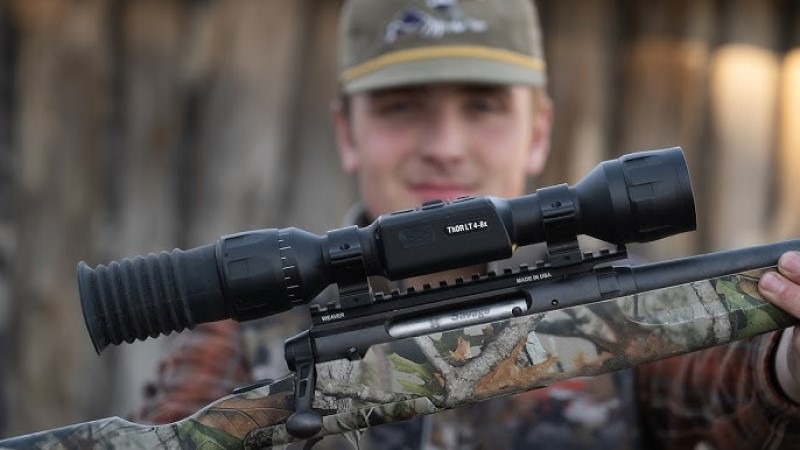
The ATN ThOR 4 640 is like stepping into the future of scopes. I used this scope extensively, and it does work. It’s a high-tech piece of gear, but as with any sophisticated tool, there were a few bumps along the way.
Let me start with the wow factor. This thing? It’s a night vision marvel. Thermal imaging is mind-blowing; it’s like having superhero vision. Hunting at night felt like a whole new ball game—I could spot targets with ease. The clarity, especially at longer distances, left me impressed, feeling like I had a secret edge.
But let’s talk about the snags. The learning curve is steep. There’s a multitude of features and settings, which can feel overwhelming at first. My advice? Take your time, read the manual, and explore. Once you get the hang of it, it’s like unlocking a treasure chest of possibilities.
Battery life is another point to consider. It’s decent, but when you’re having too much fun playing with the various modes and options, it might drain faster than you’d like. Keep a spare battery handy—it’ll save you from disappointment.
The user interface? It’s good but could be smoother. Sometimes, navigating through menus felt a bit clunky, like using an older smartphone. It gets the job done.
Despite the learning curve and a few niggles, I suggest this scope if you’re serious about night vision hunting. It’s like having an unfair advantage—once you get comfortable with it, you’ll feel like you’ve upgraded your hunting game to superhero levels.
Pros:
- Outstanding thermal imaging for night vision
- High-tech features and functionalities
- Accurate and impressive clarity
- Versatile capabilities for night hunting
- Superior performance once mastered
Cons:
- Steep learning curve with multiple features
- Battery life might drain quickly with heavy use
- User interface could be smoother
- Illumination may lack in dim conditions

ATN ThOR 4 Rifle Scope
6. EOTech XPS2

The EOTech XPS2 is like the sleek, reliable companion you want on your firearm. I’ve used this scope extensively, and let me tell you, it does work. It’s a solid optic, but like anything, a few quirks might show up along the way.
First off, the good stuff. This thing is lightning fast. The reticle? Crystal clear, and the holographic technology makes target acquisition lightning-quick. It’s like having a cheat code for aiming—effortless and precise.
But here’s the catch. Battery life. It’s not terrible, but it’s not marathon-worthy either. You might want to keep spare batteries in your kit—nothing spoils a good shooting day like a dead optic.
Mounting can be a bit finicky, especially if you’re transitioning from a different optic system. Getting it right might take a few tries, but once it’s set, it’s rock solid.
The buttons? They could use some love. They’re small and could be more intuitive, especially in low-light situations. Picture fumbling for your keys in the dark—frustrating, but you’ll get the hang of it with practice.
The EOTech XPS2, if speed and precision are your game. It’s like upgrading from a regular sedan to a sports car—it’s snappy, efficient, and adds a touch of high-tech wizardry to your shooting experience.
Pros:
- Lightning-fast reticle for quick target acquisition
- Compact and efficient design
- Crisp holographic technology
- Reliable performance for speed and precision
- Good overall durability
Cons:
- Limited battery life
- Small and less intuitive buttons
- Mounting might need adjustment
- Not as crisp turret adjustments as higher-end scopes

EOTECH XPS2-300 Blackout Holographic Sight
7. Trijicon ACOG

The Trijicon ACOG is like the reliable workhorse of scopes. I’ve used this optic extensively, and let me tell you, it works—reliably, consistently, every single time. But, as with any tool, a few things cropped up during my time with it.
Let’s start with the good. This scope? It’s a legend. The clarity of the glass is top-notch, delivering crisp images even in challenging conditions. And that reticle? It’s a thing of beauty—designed for speed and accuracy, like having a built-in GPS for your bullets.
However, there are a couple of issues you might encounter. Eye relief? It’s tight. Finding that sweet spot for your eye placement can take some getting used to, but once you’ve got it, it’s like finding the perfect seat at a concert.
Battery-free? Yes, that’s a plus, but the illumination can be a bit lacking in dim conditions. It’s like trying to read in a poorly lit room—a slight challenge but not a deal-breaker.
Mounting? It’s a breeze on the right platform, but on some rifles, it might need extra accessories or modifications. It’s like trying to fit a square peg into a round hole—possible but might need some adjustments.
I suggest the Trijicon ACOG if reliability and ruggedness are your priorities. It’s like having a trusty old friend by your side—dependable, sturdy, and always ready for action.
Pros:
- Legendary reliability and durability
- Superior clarity and reticle precision
- Battery-free illumination
- Consistent performance in harsh conditions
- Dependable for rugged use
Cons:
- Limited eye relief
- Illumination might lack in low-light conditions
- Mounting could be challenging on certain platforms
- Turret adjustments might not be as crisp as higher-end models

Trijicon 4×32 ACOG Riflescope
My Buying Guide for the Best .300 Blackout Scopes
In my experience, finding the perfect scope for a .300 Blackout rifle is like searching for a needle in a haystack. But fear not, I’ve navigated through scopes aplenty and here’s what I’ve learned—trust me, it’s worth the effort.
Picture Clarity:
The sight picture is the soul of a scope. It doesn’t matter how great the features are; if the image is blurry or dim, you’re in for a world of disappointment. Seek out scopes with top-tier glass—clear, distortion-free lenses that make your target pop.
Durability
Ever had a scope give up on you at the worst possible moment? It’s not fun. Look for a scope that laughs in the face of water, shock, and fog. O-ring seals, nitrogen purging, and sturdy housing made from the toughest materials will keep your scope in the game when it matters most.
Build Material
A scope is like armor for your rifle. You want it tough but not weighing you down like a brick. Aircraft-grade aluminum or similar sturdy alloys strike the right balance—lightweight yet rugged. Single-piece housing? That’s the gold standard for durability.
Magnification Dilemma:
Fixed or variable magnification? It’s like choosing between a jack-of-all-trades and a master of one. Fixed magnification scopes are simple, sturdy but lack versatility. Variable scopes? They’re like Swiss Army knives—versatile but potentially more prone to issues. Choose wisely.
Value Matters:
Here’s the deal—every feature might seem exciting, but are they necessary? Ensure your scope has the essentials for your shooting needs before falling for flashy add-ons. Also, don’t break the bank for features you’ll rarely use.
Common Problems & Solutions
Problem: Blurry sight picture. Solution: Ensure lenses are clean and use anti-fog solutions. If the issue persists, check for lens defects or replace if necessary.
Problem: Scope mounting troubles. Solution: Seek professional help for proper mounting or invest in high-quality mounts and rings for stability.
Problem: Battery drainage. Solution: Keep spare batteries and opt for scopes with longer-lasting battery life or battery-free options.
Problem: Eye relief issues. Solution: Adjust eye placement and consider scopes with more forgiving eye relief.
FAQs
What scope for 300 Blackout bolt action?
For those craving precision within the 25 to 300-yard range with the .300 Blackout, I’ve found that lightweight 4x optics hit the mark splendidly. Personally, the Trijicon ACOG has a special place in my gear collection. Its reliability and accuracy make it a top choice for bolt action enthusiasts like myself.
How far can 300 BLK shoot?
The .300 Blackout’s range varies with different rounds and barrel lengths. When firing a 125-grain bullet from a 16-inch barrel, I’ve seen an effective reach of about 500 yards. Drop that same ammo into a 9-inch barrel, and you’re looking at around 480 yards. It’s all about finding that sweet spot for your preferred setup.
Is 300 Blackout better in a short or long barrel?
The 300 Blackout runs at an average velocity of 2200 feet per second. But extend that barrel to 16 inches, and suddenly you’re cruising at approximately 2400fps. Longer barrels provide that extra edge, offering better stabilization from firing to muzzle exit. It’s all about optimizing for your desired performance.
What is the advantage of 300 Blackout?
The .300 Blackout’s heavier projectiles bring the kinetic energy you need, especially for medium-sized games. Plus, its design optimizes powder burn in shorter barrels, making it a powerhouse in SBRs and larger pistols. Efficiency and power rolled into one compact cartridge—that’s what sets it apart.
Is a 300 Blackout or 308 better for deer hunting?
When it comes to long-range shooting and hunting big game, the .308 takes the lead. But if versatility is your game, slotting it into an AR-10 for tactical pursuits can be a game-changer. On the flip side, the 300 Blackout shines in self-defence and close-quarters scenarios, making it an intuitive choice.
My Final Thoughts
Choosing a .300 Blackout scope is an investment—a trusty companion for your shooting adventures. Picture clarity, durability, build material, the magnification dilemma, and overall value are the pillars. Find the balance that suits your needs, and you’ll have a partner that enhances your shooting experience.




